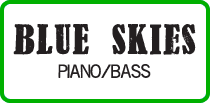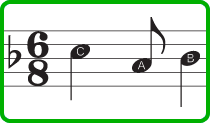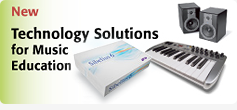Power tools
These pages refer solely to the upgrade from Sibelius 1.x, 2.x, 3.x and 4.x to Sibelius 5. Please refer to the FAQ relating to the more recent upgrade to
Sibelius 6.

Music Fonts
 Reprise™: Reprise is the latest in Sibelius’s growing range of elegant fonts. In fact, Reprise is a whole family of 9 fonts that produce an astonishingly realistic simulation of handcopying. Its music symbols are drawn with a fixed-width nib (rather than the italic nib used in Inkpen2), and additionally it includes two rubber-stamp fonts for titles and other large text. Special characters and plug-ins are included for adding hand-drawn lines and boxes to text and rehearsal marks, and house styles for incorporating Reprise into scores. Overall Reprise is a beautiful reproduction of traditional hand-copying, in a style particularly suitable for jazz, lead sheets, big band, and show music.
Reprise™: Reprise is the latest in Sibelius’s growing range of elegant fonts. In fact, Reprise is a whole family of 9 fonts that produce an astonishingly realistic simulation of handcopying. Its music symbols are drawn with a fixed-width nib (rather than the italic nib used in Inkpen2), and additionally it includes two rubber-stamp fonts for titles and other large text. Special characters and plug-ins are included for adding hand-drawn lines and boxes to text and rehearsal marks, and house styles for incorporating Reprise into scores. Overall Reprise is a beautiful reproduction of traditional hand-copying, in a style particularly suitable for jazz, lead sheets, big band, and show music.
 Opus Note Names: The new Opus Note Names font lets you write the names of notes inside the notehead – ideal if you’re writing music for students who are just taking up an instrument, particularly those learning piano.
Opus Note Names: The new Opus Note Names font lets you write the names of notes inside the notehead – ideal if you’re writing music for students who are just taking up an instrument, particularly those learning piano.
Chord symbols: There are two new fonts for chord symbols – Opus Chords Sans and Opus Chords Sans Condensed – with regular and narrow sans serif characters, similar to Arial / Helvetica. Plus various extra characters can now be included in chord symbols.
 Functional analysis: Musicologists and students can now write functional analysis in Sibelius 5, thanks to the new Opus Function Symbols font and text style.
Functional analysis: Musicologists and students can now write functional analysis in Sibelius 5, thanks to the new Opus Function Symbols font and text style.
Early music & avant garde: Sibelius 5 now includes over 200 extra music symbols for early and contemporary music, such as prolations, Bach ornaments and clusters.
Fits lyrics to music
To save typing all the lyrics into a score, you can now add them automatically from a text file – Sibelius 5 even splits them into syllables for you. Or if you type the lyrics in yourself, Sibelius will check that you’ve split syllables in all the right places.
Plug-ins
You can now undo plug-ins, so you needn’t be afraid of trying them out!
What’s more, the ManuScript language used to write plug-ins now supports tuplets, object deletion, notehead types, bar number changes, cue-sized objects, blank pages, time positions, score duration, and lyric syllabification. This makes current and future plug-ins far more powerful. With a total of over 100 plug-ins, the latest ones in Sibelius 5 include:
 Tuplets: Split, join and modify tuplets, e.g. turn two triplets into a sextuplet, or a sextuplet into a quintuplet. Many other plug-ins now work with tuplets, too.
Tuplets: Split, join and modify tuplets, e.g. turn two triplets into a sextuplet, or a sextuplet into a quintuplet. Many other plug-ins now work with tuplets, too.
Simplify Notation: Cleans up music input from Flexi-time or a MIDI file by adjusting note values, split points, voicing, etc..
Film scoring: Fit a passage of music into an exact time by adjusting tempos, and show the exact rhythmic position of all hit points.
Transform Scale: Turn music from one scale into another, e.g. minor to pentatonic.
« Previous: Complete layout control | Next: More new features »
What's new for education
Summary of what's new in Sibelius 5
Capture, use and re-use snippets
A new, clearer way of viewing music
150+ high-quality built-in sounds
Mix and match from different libraries
Instrumental parts made even easier
Flexible page layout and numbering
New fonts and plug-ins
Over forty other improvements
Maximise access for your students
Questions about the upgrade


